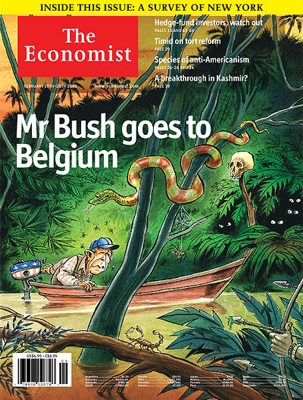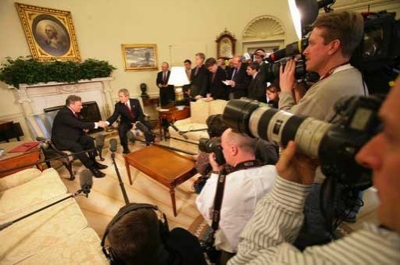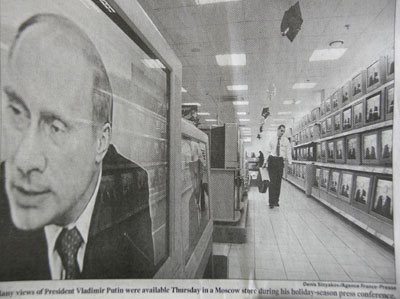Notes
Bush Snakes Through Europe (Or: Art of Darkness)

I have been looking at photo coverage of W’s trip to Europe, but the most interesting image I found was this illustration on the cover of The Economist. (Larger version here.) I’d be happy for your comments, because the jungle analogy seems to “miss the boat.” If anything, it suggests a significant gap between how the Administration perceives Europe, and how Europe (or, at least the Economist) thinks the Administration perceives it.
I mean, do the Europeans seriously equate this trip to Bush entering a treacherous forest? The way Bush/Cheney/Rummy view the Europeans, a sandbox might have made a better metaphor. Geography, this image actually seems more suggestive of the United States, where various cowboy-types have always been bent on taming the wild. The hand with the bow-and-arrow in the lower right corner contributes to this sense. Symbolically, what native group in Europe has a pull stronger than the American Indian? (On the other hand, if you assume Bush is traveling down the Mediterranean — even though his trip takes place further north — you could make a case for the hand on the bow being African. …And, what’s with that arrow tip? Maybe the person aiming the arrow is actually one of those woodland-loving Greens still ticked off about Kyoto.)
Maybe, though, the boat is on an American tributary, after all. If you told me this image depicted the second-term Bush traversing the political wilds at home, having to navigate between foes on both the left and right (maybe that’s Hillary in the tree, Howard Dean setting up the arrows, or the skeleton of his father’s “no new taxes” pledge), that would make more sense.
Getting back to Europe, however, could the antagonists in the graphic represent specific adversaries? Considering that Bush met with representatives of NATO, the EC and the EU, as well as Chirac, Blair, Yushenko, Berlusconi, Schroeder, and Putin, and three of the nine — Blair, Yushenko and Berlusconi — are either allies, or insignificant players, that leaves six potential attackers. That number matches the six threats in the illustration (the snake, skull, scorpion, native, spider, and eyeballs). With that symmetry, who’s to say you couldn’t match real life players with illustrated counterparts?
Maybe the giant snake hanging over Bush’s head could be the EU, for example. With a population a third larger than the U.S., it appears the snake — if completely unfurled — might prove about that much bigger than the boat, which, with a motor painted like the American flag, seems to clearly represent the U.S. In terms of other actors, Chirac could be the scorpion. Although France is nowhere near equal to the U.S. in scale, ol’ Jacque is famous for shaking a pincer at Bush. Over the past few years, he has certainly also shown he knows when to pinch and where he can sting.
Of course, another way to look at this picture is from a directional perspective. In that case, it’s helpful to read the text supplied with the illustration:
George Bush is about to venture bravely into darkest Belgium, and beyond into Europe’s interior. For the moment, the natives are friendlier than before, but those grins can be deceptive….
Bush’s trip involves three stops, each destination lying further east — the same direction he’s moving in the drawing. Following Brussels, Bush heads for Mainz, Germany to meet with Gerhard Schroeder. The last (or, most interior) stop is Bratislava in Slovakia, where Bush meets with Vladimir Putin. Coincidence or not, both of these cities are on large rivers. The main river that passes through Mainz is the Rhine. Bratislava happens to sit beside the Danube.
Because both cities lie on the northern bank of these rivers, they would equate with the top, or far bank in the illustration. Since Bush visits Germany first, and the skull precedes the spooky eyes in terms of perspective, the skull could be seen to represent Schroeder and the Germans. In contrast to the conciliatory tone between Bush and Chirac, Schroeder seems to be the one European leader who keeps rattling old skeletons. Last week, the Chancellor challenged the U.S. to recognize the EU as the military successor to NATO. Schroeder has also become Bush’s harshest opponent regarding negotiations with Iran. Just last week, he challenged the U.S. scenario that the situation automatically be taken up by the U.N. Security Council if European-Iranian talks failed.
Of course, the spooky eyes at the furthest point of the river can easily represent Putin. The former spy has steered his country into a dank and edgy darkness.
(image: economist.com/)


Reactions
Comments Powered by Disqus